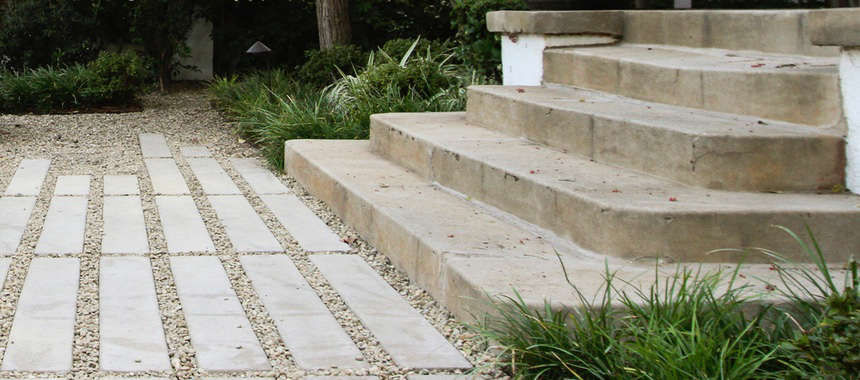
As a landscape designer in Northern California for more than 15 years, I often find myself talking about the importance of “good bones”—the important design concept of strong structure to make a garden space grounded and attractive year round.
While plants can provide some of this framework, I prefer to use elements that remain even after the flowers and leaves blow away.
Photograph by Michele Lee Willson courtesy of Arterra Landscape Architects.
Poured-in-place concrete creates built-in seating in a California garden. Poured-in-place concrete (or sometimes called cast-in-place concrete) is a type of building material that is poured into forms where it will set, be finished and remain almost permanently.
What is poured-in-place concrete and why do I need it?
Photograph courtesy of Alexander Designs.
The question is almost what can’t you create? With poured-in-place concrete, you can build many different types of customs elements including patios, pathways, stairs, benches, fire pits, driveways, water features, retaining walls, planters, and lawn edging.
What type of elements can you create with poured-in-place concrete?
My top picks for poured-in-place concrete elements:
Concrete planters are home to a variety of shade plants. Design tip: By creating many landscape elements with one cohesive material, like poured-in-place concrete, you can enhance continuity and flow and eliminate the possible mishmash.
Photograph courtesy of Scott Lewis Landscape Architecture.
Specht Harpman Architects (now Specht Architects) won a 2013 Gardenista Design Award for a landscape created in collaboration with Gunn Landscape Architecture.
As the name suggests, liquid concrete is poured into molds or forms made to the design specifications, including depth, width, and height. Without getting into the nitty gritty details, the basics are: in general, plywood, and steel forms are set and secured in place.
How do you pour concrete?
Poured concrete steps in a landscape by Pedersen Associates, members of our Architect and Designer directory. Then after the concrete sets and dries, the forms are dismantled and a skilled concrete craftsman can add patterns or stains if you want a certain look.
Photograph by Jennifer Roper.
Garden Designer Naomi Sanders added a walkway of cast concrete pavers to match an existing concrete stoop in Before & After: A Grande Dame in LA’s Hancock Park.
When do I need a concrete truck parked in front of my house?
Basically, anything over one cubic yard should be pumped in by a truck and not mixed by hand or in a standing mixer. What I mean is that when you use bagged concrete there is a risk of each batch being different, whereas a concrete truck delivers a uniform mix.
A poured in place concrete bench in the garden of the Glassell Boathouse in LA (available to rent on Airbnb).
The cost to build with poured-in-place concrete can range from about $65 to $110 per square face foot, depending on the site conditions and design specifications.
How much does poured-in-place concrete cost?
Photograph by Matthew Williams.
A concrete trough fountain sits in a gravel bed in landscape architect Christine Ten Eyck’s Austin, Texas backyard.
Poured-in-Place Concrete Recap
Photograph courtesy of Urban Organics Design.
Pros:
• Almost Herculean strength, able to hold back tons of earth and water, making it a solid choice for retaining walls. • Needs a cleaning only every few months with a commercial concrete cleaner if water stains, moss, or dirt muck up the surface.
Cons:
• A skilled concrete contractor should be hired to design and install. • Can crack and erode over time because of rain, snow, and tree roots but can be repaired with mortar.